LLMs In Robotics Market Size 2025-2029
The llms in robotics market size is valued to increase by USD 12.01 billion, at a CAGR of 38.2% from 2024 to 2029. Proliferation of advanced foundational models and multimodal integration will drive the llms in robotics market.
Major Market Trends & Insights
- APAC dominated the market and accounted for a 40% growth during the forecast period.
- By Deployment - Cloud-based segment was valued at USD 1.02 billion in 2023
- By Application - Industrial robotics segment accounted for the largest market revenue share in 2023
Market Size & Forecast
- Market Opportunities: USD 692.93 million
- Market Future Opportunities: USD 12013.60 million
- CAGR from 2024 to 2029 : 38.2%
Market Summary
- The market is experiencing significant growth, with an estimated value surpassing USD30 billion in 2021. This expansion is driven by the proliferation of advanced foundational models and multimodal integration, which enable robots to understand and respond to complex human language and visual cues. The convergence of language, vision, and action through these models represents a pivotal moment in robotics technology. However, challenges persist in ensuring real-world grounding and system reliability. As multimodal foundation models become increasingly sophisticated, they must be able to effectively navigate and adapt to real-world environments.
- This requires ongoing research and development in areas such as machine learning, computer vision, and natural language processing. Despite these challenges, the future of the market remains bright, with potential applications spanning industries from manufacturing and healthcare to education and customer service. The integration of advanced robotic systems into various sectors promises to revolutionize productivity, efficiency, and human-robot interaction.
What will be the Size of the LLMs In Robotics Market during the forecast period?
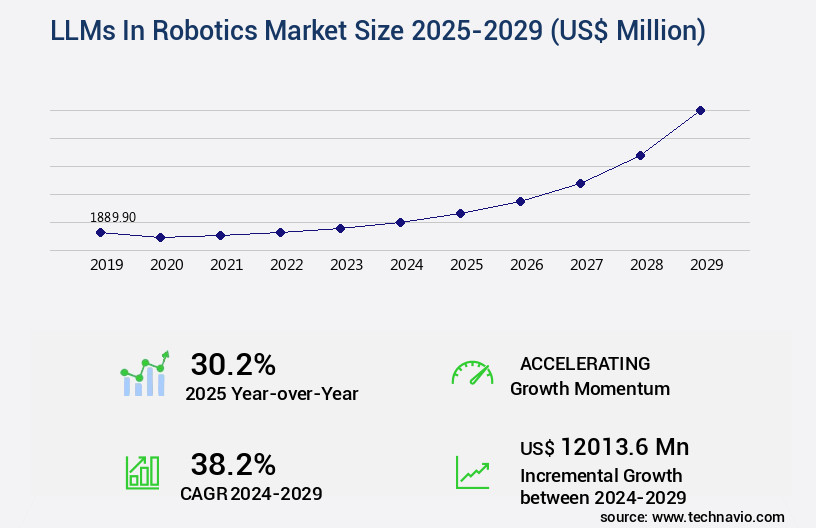
Get Key Insights on Market Forecast (PDF) Request Free Sample
How is the LLMs In Robotics Market Segmented ?
The llms in robotics industry research report provides comprehensive data (region-wise segment analysis), with forecasts and estimates in "USD million" for the period 2025-2029, as well as historical data from 2019-2023 for the following segments.
- Deployment
- Application
- Industrial robotics
- Service robotics
- Autonomous vehicles
- Humanoid robots
- Others
- End-user
- Healthcare
- Manufacturing
- Retail and E-commerce
- Defense and security
- Others
- Geography
- North America
- Europe
- APAC
- China
- India
- Japan
- South Korea
- South America
- Rest of World (ROW)
By Deployment Insights
The cloud-based segment is estimated to witness significant growth during the forecast period.
The market continues to evolve, with cloud-based deployment models leading the charge. This dominance stems from the immense computational resources needed to train and operate advanced Large Language Models (LLMs), such as OpenAI's GPT series, Google's Gemini, and Anthropic Claude. Housed in hyperscale data centers, these LLMs process complex reasoning, planning, and decision-making tasks for robotics applications. Robots act as edge devices, capturing sensory data and transmitting it to the cloud for processing. Real-time control systems, including fault detection, actuator control, grasp planning, and motion control, are crucial for effective data transmission and execution of instructions. Reinforcement learning, robotics simulation software, and natural language processing facilitate seamless interaction between humans and robots.
Remote operation, autonomous navigation, and robotics process automation are further enhanced by AI-powered robotics and path planning algorithms. Computer vision systems, collision avoidance, and object recognition rely on sensor data integration and deep learning models. Human-robot collaboration, inverse kinematics, dexterous manipulation, and task automation systems all benefit from these advancements, enabling robots to learn and adapt in 3D environments. A recent study estimates that the global robotics market, driven by these innovations, will reach a value of USD153.3 billion by 2026, underscoring the significant impact of these technologies.
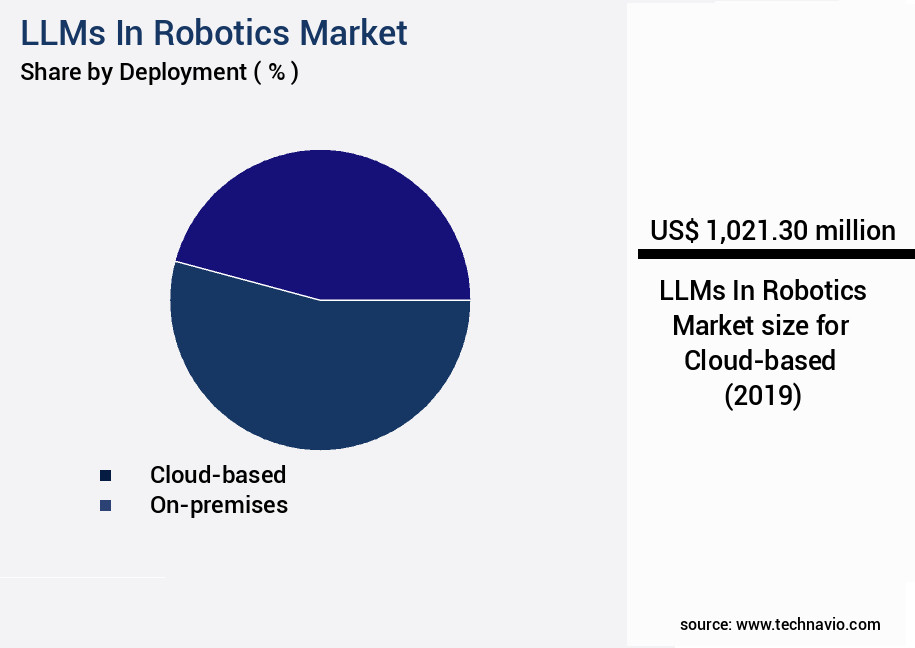
Request Free Sample
The Cloud-based segment was valued at USD 1.02 billion in 2019 and showed a gradual increase during the forecast period.
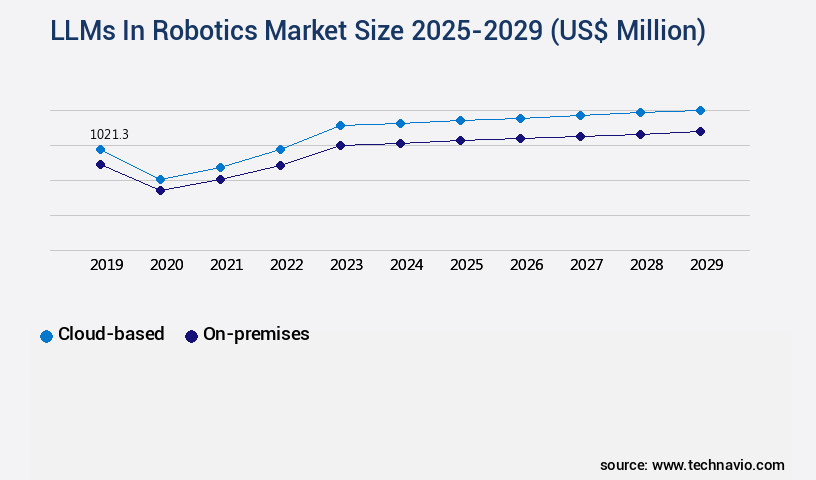
Request Free Sample
Regional Analysis
APAC is estimated to contribute 40% to the growth of the global market during the forecast period.Technavio’s analysts have elaborately explained the regional trends and drivers that shape the market during the forecast period.
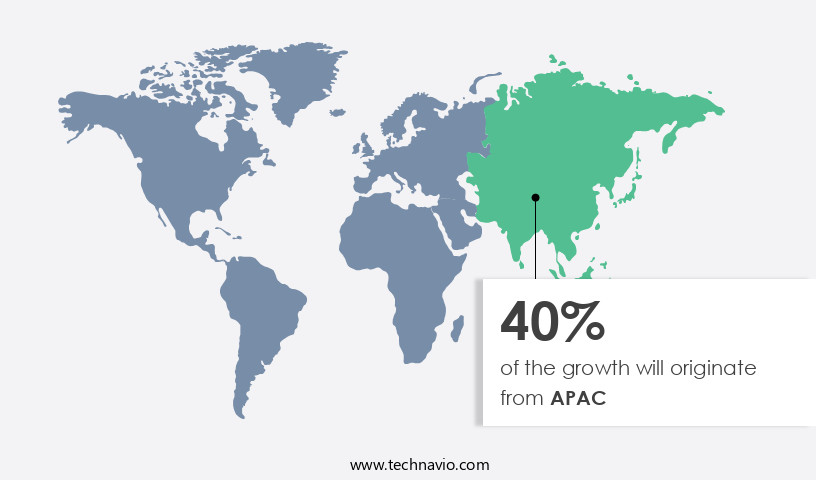
See How LLMs In Robotics Market Demand is Rising in APAC Request Free Sample
The Asia-Pacific (APAC) market for LLMs in robotics is experiencing a dynamic and robust growth trajectory, driven by intensive government support, a vast manufacturing sector, and distinctive demographic trends. China, Japan, and South Korea lead this technological advancement wave. China, in particular, is making significant strides in artificial intelligence and robotics, viewing these technologies as essential for future economic competitiveness and national security. The Chinese Ministry of Industry and Information Technology released an action plan for humanoid robots in November 2023, underscoring the country's commitment to this sector.
Japan, with its advanced robotics industry and aging population, is leveraging LLMs in robotics to address labor shortages and improve efficiency. South Korea, known for its electronics manufacturing prowess, is also investing heavily in robotics automation. This region's diverse national markets, each with distinct strategic priorities, contribute to the overall growth and evolution of the market in APAC.
Market Dynamics
Our researchers analyzed the data with 2024 as the base year, along with the key drivers, trends, and challenges. A holistic analysis of drivers will help companies refine their marketing strategies to gain a competitive advantage.
The market is experiencing significant growth as businesses and organizations seek to integrate advanced robotic control systems into their operations. One key area of focus is the development of natural language interfaces for robotic manipulators, allowing for more intuitive human-robot interaction. In robotics research, reinforcement learning and robotic task planning are being used to enable robots to learn and adapt to new environments.
Deep learning and object recognition are also crucial components of modern robotics, with computer vision-based navigation systems enabling autonomous robots to navigate complex environments. AI-driven path planning algorithms are essential for mobile robots, ensuring real-time performance and precise movements.
Human-robot interaction is another important area of development, with natural language dialogue systems enabling more effective communication between humans and robots. Robotics simulation software is a vital tool for ensuring model accuracy and testing complex dexterous manipulation tasks in various environments.
Autonomous navigation algorithms are essential for robots operating in dynamic environments, with sensor data fusion and robot localization techniques enabling effective collision avoidance and safety mechanisms. Control architectures must be designed to manage resources efficiently and ensure reliable actuator control.
Predictive maintenance and fault detection systems are becoming increasingly important for robotic applications, with cloud computing infrastructure providing the necessary computational power for large-scale deployments. Ethical considerations are also a critical factor in the development of AI robotics, ensuring that these systems are safe, reliable, and aligned with human values.
Overall, the market is a dynamic and rapidly evolving field, with a range of advanced technologies and applications driving innovation and growth. From manufacturing and logistics to healthcare and education, robots are transforming the way we work and live, and the demand for more sophisticated and adaptive systems is only increasing.
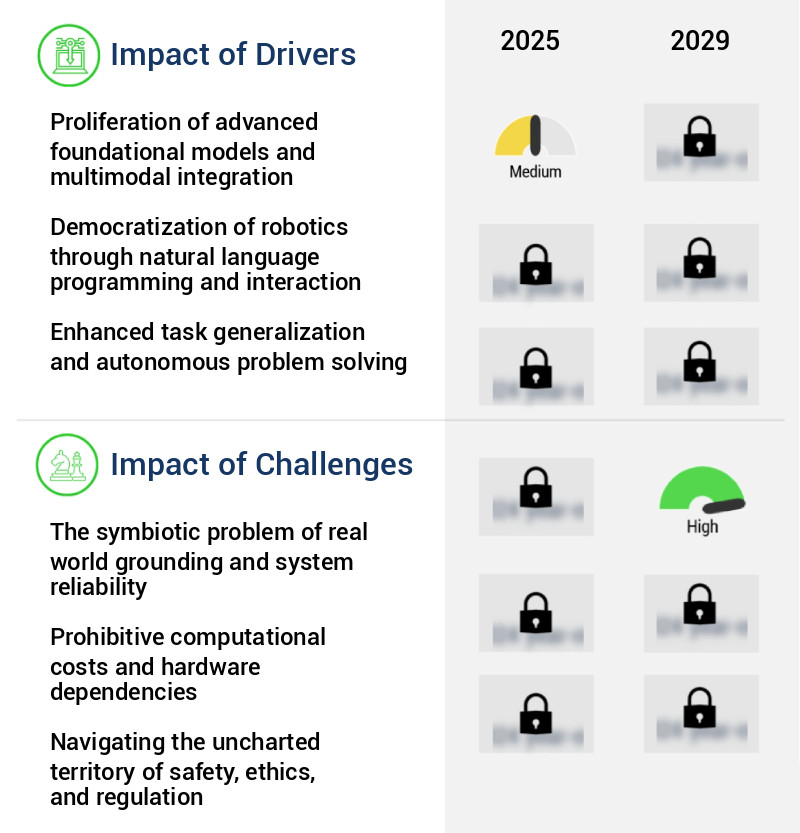
What are the key market drivers leading to the rise in the adoption of LLMs In Robotics Industry?
- The proliferation of advanced foundational models and the integration of multiple modalities are the primary factors fueling market growth.
- The Large Language Models in robotics market is experiencing a significant evolution, driven by the rapid advancement and integration of multimodal foundational models. These models, capable of processing and synthesizing information from various data streams including text, images, video, and sensor readings, mark a shift from traditional, task-specific artificial intelligence. This transformation holds immense importance for the robotics sector, characterized by its physical and sensor-rich nature. By serving as the cognitive core for a diverse range of robotic applications, a single, pre-trained model reduces development time, lowers the entry barrier for new market entrants, and expedites the return on investment for deploying robotic systems.
- The integration of large language models in robotics is poised to revolutionize industries such as manufacturing, healthcare, and logistics, offering enhanced efficiency, accuracy, and adaptability.
What are the market trends shaping the LLMs In Robotics Industry?
- The convergence of language, vision, and action represents a significant market trend, driven by the increasing use of multimodal foundation models.
- The Large Language Models (LLMs) in robotics market is witnessing a transformative phase with the emergence of multimodal foundation models, particularly Vision-Language-Action (VLA) models. This evolution signifies a shift from separate systems for perception, reasoning, and control towards a unified neural network architecture. VLA models enable robots to process and synthesize information from multiple modalities, including visual input and natural language instructions. This integration empowers robots to transcend pre-programmed, repetitive tasks in structured environments and operate autonomously and adaptively in complex, dynamic human settings. According to recent estimates, the global robotics market is projected to reach a value of over USD150 billion by 2025, with a significant portion attributed to the adoption of advanced LLMs.
- Another study suggests that the market for AI in robotics is expected to grow at a compound annual growth rate (CAGR) of approximately 30% from 2020 to 2027. These trends underscore the increasing importance of LLMs in robotics and their potential applications across various sectors, including manufacturing, healthcare, agriculture, and logistics.
What challenges does the LLMs In Robotics Industry face during its growth?
- The symbiotic challenge of ensuring real-world grounding and system reliability is a critical issue that significantly impacts industry growth. This complex problem requires a comprehensive approach to ensure the seamless integration of technology with the real world, while maintaining the highest levels of system dependability and robustness.
- The market is experiencing significant evolution, driven by advancements in artificial intelligence and machine learning technologies. These models, which excel in processing and understanding natural language, hold immense potential for various sectors. For instance, in healthcare, LLMs can analyze patient records and diagnose diseases, while in manufacturing, they can optimize production processes. However, a major challenge impeding their widespread commercial adoption is the issue of grounding and reliability. Grounding refers to the process of connecting abstract, symbolic knowledge within an LLM to the physical world, which is crucial for ensuring system reliability and predictability. Despite this hurdle, the integration of LLMs in robotics continues to gain traction, with the number of applications growing rapidly.
- For example, in the automotive industry, LLMs are being used to enhance voice recognition systems and improve customer interaction. Additionally, the education sector is exploring the use of LLMs to create personalized learning experiences. Overall, the potential applications of LLMs in robotics are vast and diverse, offering significant opportunities for innovation and growth.
Exclusive Technavio Analysis on Customer Landscape
The llms in robotics market forecasting report includes the adoption lifecycle of the market, covering from the innovator’s stage to the laggard’s stage. It focuses on adoption rates in different regions based on penetration. Furthermore, the llms in robotics market report also includes key purchase criteria and drivers of price sensitivity to help companies evaluate and develop their market growth analysis strategies.
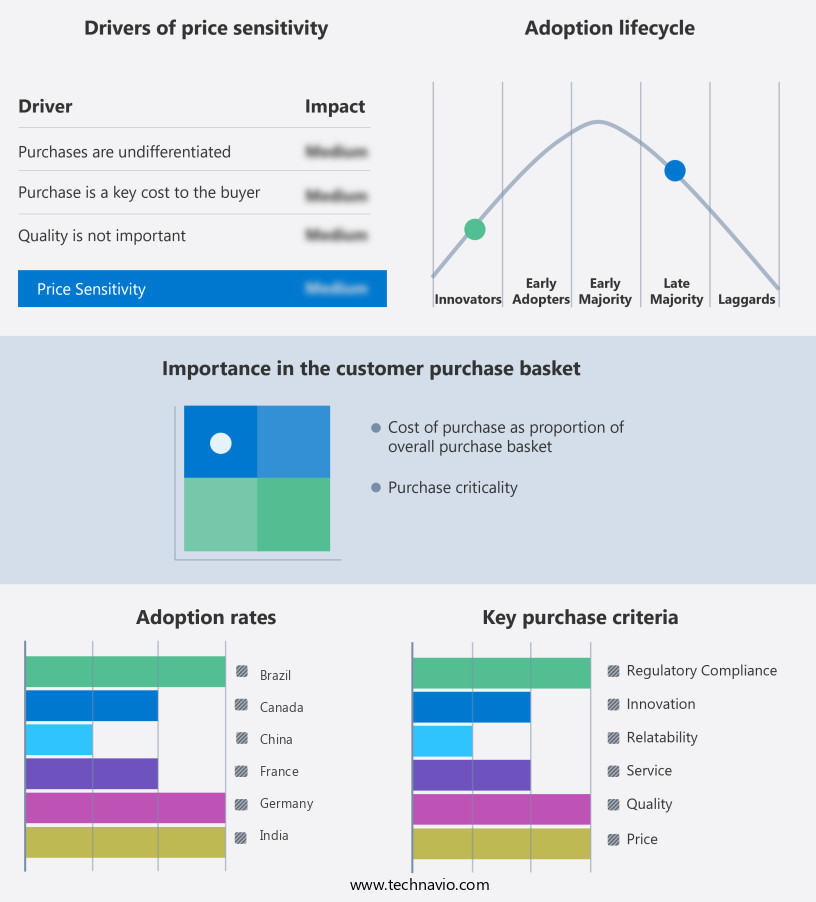
Customer Landscape of LLMs In Robotics Industry
Competitive Landscape
Companies are implementing various strategies, such as strategic alliances, llms in robotics market forecast, partnerships, mergers and acquisitions, geographical expansion, and product/service launches, to enhance their presence in the industry.
1X - This company specializes in manufacturing humanoid robots for both consumer and commercial markets, featuring advanced AI integration through a partnership with OpenAI, enhancing their capabilities for efficient task execution.
The industry research and growth report includes detailed analyses of the competitive landscape of the market and information about key companies, including:
- 1X
- Agility Robotics Inc.
- Amazon Web Services Inc.
- Apptronik Inc.
- Boston Dynamics Inc.
- Figure AI Inc.
- Google DeepMind
- Hugging Face
- KUKA AG
- Meta Platforms Inc.
- Microsoft Corp.
- NVIDIA Corp.
- OpenAI
- Sanctuary Cognitive Systems Corporation
- Tesla Inc.
- UiPath Inc.
- United Robotics Group GmbH
Qualitative and quantitative analysis of companies has been conducted to help clients understand the wider business environment as well as the strengths and weaknesses of key industry players. Data is qualitatively analyzed to categorize companies as pure play, category-focused, industry-focused, and diversified; it is quantitatively analyzed to categorize companies as dominant, leading, strong, tentative, and weak.
Recent Development and News in LLMs In Robotics Market
- In January 2024, Carnegie Mellon University announced the launch of a new LLM (Master of Science in Law and Technology) program focused on Robotics, in collaboration with their Robotics Institute. This program aims to prepare students for legal roles in the robotics industry (Source: Carnegie Mellon University Press Release).
- In March 2024, ABB Robotics, a leading robotics company, entered into a strategic partnership with MIT to advance research and development in robotics and automation. This collaboration includes joint research projects and the exchange of expertise between the two organizations (Source: ABB Robotics Press Release).
- In May 2024, Fanuc Corporation, a major robotics manufacturer, completed the acquisition of Cognex Corporation's industrial vision business for approximately USD1.8 billion. This acquisition expands Fanuc's product portfolio, strengthening its position in the robotics market (Source: Fanuc Corporation SEC Filing).
- In April 2025, the European Union passed the new Artificial Intelligence Act, which includes regulations for the development, deployment, and use of robotics and AI systems. This legislation sets guidelines for ethical AI use and data protection, affecting the entire European robotics market (Source: European Parliament Press Release).
Dive into Technavio’s robust research methodology, blending expert interviews, extensive data synthesis, and validated models for unparalleled LLMs In Robotics Market insights. See full methodology.
|
Market Scope
|
|
Report Coverage
|
Details
|
|
Page number
|
243
|
|
Base year
|
2024
|
|
Historic period
|
2019-2023 |
|
Forecast period
|
2025-2029
|
|
Growth momentum & CAGR
|
Accelerate at a CAGR of 38.2%
|
|
Market growth 2025-2029
|
USD 12013.6 million
|
|
Market structure
|
Fragmented
|
|
YoY growth 2024-2025(%)
|
30.2
|
|
Key countries
|
US, China, Japan, Germany, India, UK, South Korea, France, Brazil, and Canada
|
|
Competitive landscape
|
Leading Companies, Market Positioning of Companies, Competitive Strategies, and Industry Risks
|
Request Free Sample
Research Analyst Overview
- The robotics market continues to evolve, driven by advancements in technologies such as fault detection, actuator control systems, and grasp planning. Embedded systems and control architectures are becoming more sophisticated, enabling the integration of reinforcement learning and robotics simulation software. Natural language processing and remote operation are facilitating human-robot collaboration, while real-time control and 3D environment mapping are essential for autonomous navigation. One notable example of market activity is the implementation of AI-powered robotics in manufacturing, resulting in a 20% increase in production efficiency. According to industry reports, the robotics market is expected to grow by over 15% annually, fueled by the adoption of advanced technologies like deep learning models, computer vision systems, and motion control systems.
- Moreover, the integration of sensor data and collision avoidance systems is crucial for task automation and robot safety standards. Path planning algorithms and object recognition are essential components of robot manipulation skills, while inverse kinematics and dexterous manipulation enable robots to perform complex tasks. Teleoperation systems and forward kinematics are also critical for ensuring precise control and coordination between robots and their environments. Overall, the robotics market is characterized by continuous innovation and the integration of various technologies to create more advanced and versatile robotic systems. The potential applications of these systems span across various sectors, including manufacturing, healthcare, agriculture, and logistics, making the market a dynamic and exciting space to watch.
What are the Key Data Covered in this LLMs In Robotics Market Research and Growth Report?
-
What is the expected growth of the LLMs In Robotics Market between 2025 and 2029?
-
What segmentation does the market report cover?
-
The report is segmented by Deployment (Cloud-based and On-premises), Application (Industrial robotics, Service robotics, Autonomous vehicles, Humanoid robots, and Others), End-user (Healthcare, Manufacturing, Retail and E-commerce, Defense and security, and Others), and Geography (APAC, North America, Europe, Middle East and Africa, and South America)
-
Which regions are analyzed in the report?
-
APAC, North America, Europe, Middle East and Africa, and South America
-
What are the key growth drivers and market challenges?
-
Who are the major players in the LLMs In Robotics Market?
-
1X, Agility Robotics Inc., Amazon Web Services Inc., Apptronik Inc., Boston Dynamics Inc., Figure AI Inc., Google DeepMind, Hugging Face, KUKA AG, Meta Platforms Inc., Microsoft Corp., NVIDIA Corp., OpenAI, Sanctuary Cognitive Systems Corporation, Tesla Inc., UiPath Inc., and United Robotics Group GmbH
Market Research Insights
- The market for Learning Management Systems (LMS) in robotics is a dynamic and ever-evolving landscape. Two key statistics illustrate its continuous growth. First, the number of organizations integrating robotics into their training programs has increased by 25% over the past year. Second, industry analysts forecast a compound annual growth rate of 15% for the next five years. In this market, RViz visualization, model fine-tuning, and API integrations play essential roles. Robotics companies use RViz to create interactive 3D visualizations of their robots' real-time performance. Model fine-tuning enables organizations to optimize their robots' behavior through iterative improvements. API integrations facilitate seamless communication between various robotics components and the LMS.
- Additionally, simulation environments, distributed computing, hardware acceleration, and safety protocols are crucial elements in the LMS for robotics. For instance, a leading organization in the industry reported a 30% increase in sales after implementing a cloud-based simulation environment for their service robots' training. Furthermore, the market demands advanced capabilities like model evaluation metrics, system integration, data logging, error analysis, and parallel processing. Ethical considerations and maintenance protocols are also essential aspects of this evolving market. Overall, the LMS in robotics market is a vital sector that continues to adapt and innovate to meet the demands of the ever-changing robotics industry.
We can help! Our analysts can customize this llms in robotics market research report to meet your requirements.
Get in touch
1 Executive Summary
- 1.1 Market overview
- Executive Summary - Chart on Market Overview
- Executive Summary - Data Table on Market Overview
- Executive Summary - Chart on Global Market Characteristics
- Executive Summary - Chart on Market by Geography
- Executive Summary - Chart on Market Segmentation by Deployment
- Executive Summary - Chart on Market Segmentation by Application
- Executive Summary - Chart on Market Segmentation by End-user
- Executive Summary - Chart on Incremental Growth
- Executive Summary - Data Table on Incremental Growth
- Executive Summary - Chart on Company Market Positioning
2 Technavio Analysis
- 2.1 Analysis of price sensitivity, lifecycle, customer purchase basket, adoption rates, and purchase criteria
- Analysis of price sensitivity, lifecycle, customer purchase basket, adoption rates, and purchase criteria
- 2.2 Criticality of inputs and Factors of differentiation
- Overview on criticality of inputs and factors of differentiation
- 2.3 Factors of disruption
- Overview on factors of disruption
- 2.4 Impact of drivers and challenges
- Impact of drivers and challenges in 2024 and 2029
3 Market Landscape
- 3.1 Market ecosystem
- Parent Market
- Data Table on - Parent Market
- 3.2 Market characteristics
- Market characteristics analysis
4 Market Sizing
- 4.1 Market definition
- Offerings of companies included in the market definition
- 4.2 Market segment analysis
- 4.4 Market outlook: Forecast for 2024-2029
- Chart on Global - Market size and forecast 2024-2029 ($ million)
- Data Table on Global - Market size and forecast 2024-2029 ($ million)
- Chart on Global Market: Year-over-year growth 2024-2029 (%)
- Data Table on Global Market: Year-over-year growth 2024-2029 (%)
5 Historic Market Size
- 5.1 Global LLMs In Robotics Market 2019 - 2023
- Historic Market Size - Data Table on Global LLMs In Robotics Market 2019 - 2023 ($ million)
- 5.2 Deployment segment analysis 2019 - 2023
- Historic Market Size - Deployment Segment 2019 - 2023 ($ million)
- 5.3 Application segment analysis 2019 - 2023
- Historic Market Size - Application Segment 2019 - 2023 ($ million)
- 5.4 End-user segment analysis 2019 - 2023
- Historic Market Size - End-user Segment 2019 - 2023 ($ million)
- 5.5 Geography segment analysis 2019 - 2023
- Historic Market Size - Geography Segment 2019 - 2023 ($ million)
- 5.6 Country segment analysis 2019 - 2023
- Historic Market Size - Country Segment 2019 - 2023 ($ million)
6 Five Forces Analysis
- 6.1 Five forces summary
- Five forces analysis - Comparison between 2024 and 2029
- 6.2 Bargaining power of buyers
- Bargaining power of buyers - Impact of key factors 2024 and 2029
- 6.3 Bargaining power of suppliers
- Bargaining power of suppliers - Impact of key factors in 2024 and 2029
- 6.4 Threat of new entrants
- Threat of new entrants - Impact of key factors in 2024 and 2029
- 6.5 Threat of substitutes
- Threat of substitutes - Impact of key factors in 2024 and 2029
- 6.6 Threat of rivalry
- Threat of rivalry - Impact of key factors in 2024 and 2029
- 6.7 Market condition
- Chart on Market condition - Five forces 2024 and 2029
7 Market Segmentation by Deployment
- 7.1 Market segments
- Chart on Deployment - Market share 2024-2029 (%)
- Data Table on Deployment - Market share 2024-2029 (%)
- 7.2 Comparison by Deployment
- Chart on Comparison by Deployment
- Data Table on Comparison by Deployment
- 7.3 Cloud-based - Market size and forecast 2024-2029
- Chart on Cloud-based - Market size and forecast 2024-2029 ($ million)
- Data Table on Cloud-based - Market size and forecast 2024-2029 ($ million)
- Chart on Cloud-based - Year-over-year growth 2024-2029 (%)
- Data Table on Cloud-based - Year-over-year growth 2024-2029 (%)
- 7.4 On-premises - Market size and forecast 2024-2029
- Chart on On-premises - Market size and forecast 2024-2029 ($ million)
- Data Table on On-premises - Market size and forecast 2024-2029 ($ million)
- Chart on On-premises - Year-over-year growth 2024-2029 (%)
- Data Table on On-premises - Year-over-year growth 2024-2029 (%)
- 7.5 Market opportunity by Deployment
- Market opportunity by Deployment ($ million)
- Data Table on Market opportunity by Deployment ($ million)
8 Market Segmentation by Application
- 8.1 Market segments
- Chart on Application - Market share 2024-2029 (%)
- Data Table on Application - Market share 2024-2029 (%)
- 8.2 Comparison by Application
- Chart on Comparison by Application
- Data Table on Comparison by Application
- 8.3 Industrial robotics - Market size and forecast 2024-2029
- Chart on Industrial robotics - Market size and forecast 2024-2029 ($ million)
- Data Table on Industrial robotics - Market size and forecast 2024-2029 ($ million)
- Chart on Industrial robotics - Year-over-year growth 2024-2029 (%)
- Data Table on Industrial robotics - Year-over-year growth 2024-2029 (%)
- 8.4 Service robotics - Market size and forecast 2024-2029
- Chart on Service robotics - Market size and forecast 2024-2029 ($ million)
- Data Table on Service robotics - Market size and forecast 2024-2029 ($ million)
- Chart on Service robotics - Year-over-year growth 2024-2029 (%)
- Data Table on Service robotics - Year-over-year growth 2024-2029 (%)
- 8.5 Autonomous vehicles - Market size and forecast 2024-2029
- Chart on Autonomous vehicles - Market size and forecast 2024-2029 ($ million)
- Data Table on Autonomous vehicles - Market size and forecast 2024-2029 ($ million)
- Chart on Autonomous vehicles - Year-over-year growth 2024-2029 (%)
- Data Table on Autonomous vehicles - Year-over-year growth 2024-2029 (%)
- 8.6 Humanoid robots - Market size and forecast 2024-2029
- Chart on Humanoid robots - Market size and forecast 2024-2029 ($ million)
- Data Table on Humanoid robots - Market size and forecast 2024-2029 ($ million)
- Chart on Humanoid robots - Year-over-year growth 2024-2029 (%)
- Data Table on Humanoid robots - Year-over-year growth 2024-2029 (%)
- 8.7 Others - Market size and forecast 2024-2029
- Chart on Others - Market size and forecast 2024-2029 ($ million)
- Data Table on Others - Market size and forecast 2024-2029 ($ million)
- Chart on Others - Year-over-year growth 2024-2029 (%)
- Data Table on Others - Year-over-year growth 2024-2029 (%)
- 8.8 Market opportunity by Application
- Market opportunity by Application ($ million)
- Data Table on Market opportunity by Application ($ million)
9 Market Segmentation by End-user
- 9.1 Market segments
- Chart on End-user - Market share 2024-2029 (%)
- Data Table on End-user - Market share 2024-2029 (%)
- 9.2 Comparison by End-user
- Chart on Comparison by End-user
- Data Table on Comparison by End-user
- 9.3 Healthcare - Market size and forecast 2024-2029
- Chart on Healthcare - Market size and forecast 2024-2029 ($ million)
- Data Table on Healthcare - Market size and forecast 2024-2029 ($ million)
- Chart on Healthcare - Year-over-year growth 2024-2029 (%)
- Data Table on Healthcare - Year-over-year growth 2024-2029 (%)
- 9.4 Manufacturing - Market size and forecast 2024-2029
- Chart on Manufacturing - Market size and forecast 2024-2029 ($ million)
- Data Table on Manufacturing - Market size and forecast 2024-2029 ($ million)
- Chart on Manufacturing - Year-over-year growth 2024-2029 (%)
- Data Table on Manufacturing - Year-over-year growth 2024-2029 (%)
- 9.5 Retail and E-commerce - Market size and forecast 2024-2029
- Chart on Retail and E-commerce - Market size and forecast 2024-2029 ($ million)
- Data Table on Retail and E-commerce - Market size and forecast 2024-2029 ($ million)
- Chart on Retail and E-commerce - Year-over-year growth 2024-2029 (%)
- Data Table on Retail and E-commerce - Year-over-year growth 2024-2029 (%)
- 9.6 Defense and security - Market size and forecast 2024-2029
- Chart on Defense and security - Market size and forecast 2024-2029 ($ million)
- Data Table on Defense and security - Market size and forecast 2024-2029 ($ million)
- Chart on Defense and security - Year-over-year growth 2024-2029 (%)
- Data Table on Defense and security - Year-over-year growth 2024-2029 (%)
- 9.7 Others - Market size and forecast 2024-2029
- Chart on Others - Market size and forecast 2024-2029 ($ million)
- Data Table on Others - Market size and forecast 2024-2029 ($ million)
- Chart on Others - Year-over-year growth 2024-2029 (%)
- Data Table on Others - Year-over-year growth 2024-2029 (%)
- 9.8 Market opportunity by End-user
- Market opportunity by End-user ($ million)
- Data Table on Market opportunity by End-user ($ million)
10 Customer Landscape
- 10.1 Customer landscape overview
- Analysis of price sensitivity, lifecycle, customer purchase basket, adoption rates, and purchase criteria
11 Geographic Landscape
- 11.1 Geographic segmentation
- Chart on Market share by geography 2024-2029 (%)
- Data Table on Market share by geography 2024-2029 (%)
- 11.2 Geographic comparison
- Chart on Geographic comparison
- Data Table on Geographic comparison
- 11.3 APAC - Market size and forecast 2024-2029
- Chart on APAC - Market size and forecast 2024-2029 ($ million)
- Data Table on APAC - Market size and forecast 2024-2029 ($ million)
- Chart on APAC - Year-over-year growth 2024-2029 (%)
- Data Table on APAC - Year-over-year growth 2024-2029 (%)
- 11.4 North America - Market size and forecast 2024-2029
- Chart on North America - Market size and forecast 2024-2029 ($ million)
- Data Table on North America - Market size and forecast 2024-2029 ($ million)
- Chart on North America - Year-over-year growth 2024-2029 (%)
- Data Table on North America - Year-over-year growth 2024-2029 (%)
- 11.5 Europe - Market size and forecast 2024-2029
- Chart on Europe - Market size and forecast 2024-2029 ($ million)
- Data Table on Europe - Market size and forecast 2024-2029 ($ million)
- Chart on Europe - Year-over-year growth 2024-2029 (%)
- Data Table on Europe - Year-over-year growth 2024-2029 (%)
- 11.6 Middle East and Africa - Market size and forecast 2024-2029
- Chart on Middle East and Africa - Market size and forecast 2024-2029 ($ million)
- Data Table on Middle East and Africa - Market size and forecast 2024-2029 ($ million)
- Chart on Middle East and Africa - Year-over-year growth 2024-2029 (%)
- Data Table on Middle East and Africa - Year-over-year growth 2024-2029 (%)
- 11.7 South America - Market size and forecast 2024-2029
- Chart on South America - Market size and forecast 2024-2029 ($ million)
- Data Table on South America - Market size and forecast 2024-2029 ($ million)
- Chart on South America - Year-over-year growth 2024-2029 (%)
- Data Table on South America - Year-over-year growth 2024-2029 (%)
- 11.8 US - Market size and forecast 2024-2029
- Chart on US - Market size and forecast 2024-2029 ($ million)
- Data Table on US - Market size and forecast 2024-2029 ($ million)
- Chart on US - Year-over-year growth 2024-2029 (%)
- Data Table on US - Year-over-year growth 2024-2029 (%)
- 11.9 China - Market size and forecast 2024-2029
- Chart on China - Market size and forecast 2024-2029 ($ million)
- Data Table on China - Market size and forecast 2024-2029 ($ million)
- Chart on China - Year-over-year growth 2024-2029 (%)
- Data Table on China - Year-over-year growth 2024-2029 (%)
- 11.10 Japan - Market size and forecast 2024-2029
- Chart on Japan - Market size and forecast 2024-2029 ($ million)
- Data Table on Japan - Market size and forecast 2024-2029 ($ million)
- Chart on Japan - Year-over-year growth 2024-2029 (%)
- Data Table on Japan - Year-over-year growth 2024-2029 (%)
- 11.11 India - Market size and forecast 2024-2029
- Chart on India - Market size and forecast 2024-2029 ($ million)
- Data Table on India - Market size and forecast 2024-2029 ($ million)
- Chart on India - Year-over-year growth 2024-2029 (%)
- Data Table on India - Year-over-year growth 2024-2029 (%)
- 11.12 Germany - Market size and forecast 2024-2029
- Chart on Germany - Market size and forecast 2024-2029 ($ million)
- Data Table on Germany - Market size and forecast 2024-2029 ($ million)
- Chart on Germany - Year-over-year growth 2024-2029 (%)
- Data Table on Germany - Year-over-year growth 2024-2029 (%)
- 11.13 UK - Market size and forecast 2024-2029
- Chart on UK - Market size and forecast 2024-2029 ($ million)
- Data Table on UK - Market size and forecast 2024-2029 ($ million)
- Chart on UK - Year-over-year growth 2024-2029 (%)
- Data Table on UK - Year-over-year growth 2024-2029 (%)
- 11.14 South Korea - Market size and forecast 2024-2029
- Chart on South Korea - Market size and forecast 2024-2029 ($ million)
- Data Table on South Korea - Market size and forecast 2024-2029 ($ million)
- Chart on South Korea - Year-over-year growth 2024-2029 (%)
- Data Table on South Korea - Year-over-year growth 2024-2029 (%)
- 11.15 France - Market size and forecast 2024-2029
- Chart on France - Market size and forecast 2024-2029 ($ million)
- Data Table on France - Market size and forecast 2024-2029 ($ million)
- Chart on France - Year-over-year growth 2024-2029 (%)
- Data Table on France - Year-over-year growth 2024-2029 (%)
- 11.16 Canada - Market size and forecast 2024-2029
- Chart on Canada - Market size and forecast 2024-2029 ($ million)
- Data Table on Canada - Market size and forecast 2024-2029 ($ million)
- Chart on Canada - Year-over-year growth 2024-2029 (%)
- Data Table on Canada - Year-over-year growth 2024-2029 (%)
- 11.17 Brazil - Market size and forecast 2024-2029
- Chart on Brazil - Market size and forecast 2024-2029 ($ million)
- Data Table on Brazil - Market size and forecast 2024-2029 ($ million)
- Chart on Brazil - Year-over-year growth 2024-2029 (%)
- Data Table on Brazil - Year-over-year growth 2024-2029 (%)
- 11.18 Market opportunity by geography
- Market opportunity by geography ($ million)
- Data Tables on Market opportunity by geography ($ million)
12 Drivers, Challenges, and Opportunity/Restraints
- 12.3 Impact of drivers and challenges
- Impact of drivers and challenges in 2024 and 2029
- 12.4 Market opportunities/restraints
13 Competitive Landscape
- 13.2 Competitive Landscape
- Overview on criticality of inputs and factors of differentiation
- 13.3 Landscape disruption
- Overview on factors of disruption
- 13.4 Industry risks
- Impact of key risks on business
14 Competitive Analysis
- 14.2 Company ranking index
- 14.3 Market positioning of companies
- Matrix on companies position and classification
- 1X
- 1X - Overview
- 1X - Product / Service
- 1X - Key offerings
- SWOT
- 14.5 Agility Robotics Inc.
- Agility Robotics Inc. - Overview
- Agility Robotics Inc. - Product / Service
- Agility Robotics Inc. - Key offerings
- SWOT
- 14.6 Amazon Web Services Inc.
- Amazon Web Services Inc. - Overview
- Amazon Web Services Inc. - Product / Service
- Amazon Web Services Inc. - Key news
- Amazon Web Services Inc. - Key offerings
- SWOT
- 14.7 Apptronik Inc.
- Apptronik Inc. - Overview
- Apptronik Inc. - Product / Service
- Apptronik Inc. - Key offerings
- SWOT
- 14.8 Boston Dynamics Inc.
- Boston Dynamics Inc. - Overview
- Boston Dynamics Inc. - Product / Service
- Boston Dynamics Inc. - Key offerings
- SWOT
- 14.9 Figure AI Inc.
- Figure AI Inc. - Overview
- Figure AI Inc. - Product / Service
- Figure AI Inc. - Key offerings
- SWOT
- 14.10 Google DeepMind
- Google DeepMind - Overview
- Google DeepMind - Product / Service
- Google DeepMind - Key offerings
- SWOT
- 14.11 Meta Platforms Inc.
- Meta Platforms Inc. - Overview
- Meta Platforms Inc. - Business segments
- Meta Platforms Inc. - Key offerings
- Meta Platforms Inc. - Segment focus
- SWOT
- 14.12 Microsoft Corp.
- Microsoft Corp. - Overview
- Microsoft Corp. - Business segments
- Microsoft Corp. - Key news
- Microsoft Corp. - Key offerings
- Microsoft Corp. - Segment focus
- SWOT
- 14.13 NVIDIA Corp.
- NVIDIA Corp. - Overview
- NVIDIA Corp. - Business segments
- NVIDIA Corp. - Key news
- NVIDIA Corp. - Key offerings
- NVIDIA Corp. - Segment focus
- SWOT
- 14.14 OpenAI
- OpenAI - Overview
- OpenAI - Product / Service
- OpenAI - Key offerings
- SWOT
- 14.15 Sanctuary Cognitive Systems Corporation
- Sanctuary Cognitive Systems Corporation - Overview
- Sanctuary Cognitive Systems Corporation - Product / Service
- Sanctuary Cognitive Systems Corporation - Key offerings
- SWOT
- 14.16 Tesla Inc.
- Tesla Inc. - Overview
- Tesla Inc. - Business segments
- Tesla Inc. - Key news
- Tesla Inc. - Key offerings
- Tesla Inc. - Segment focus
- SWOT
- 14.17 UiPath Inc.
- UiPath Inc. - Overview
- UiPath Inc. - Product / Service
- UiPath Inc. - Key news
- UiPath Inc. - Key offerings
- SWOT
- 14.18 United Robotics Group GmbH
- United Robotics Group GmbH - Overview
- United Robotics Group GmbH - Product / Service
- United Robotics Group GmbH - Key offerings
- SWOT
15 Appendix
- 15.2 Inclusions and exclusions checklist
- Inclusions checklist
- Exclusions checklist
- 15.3 Currency conversion rates for US$
- Currency conversion rates for US$
- 15.4 Research methodology
- 15.7 Validation techniques employed for market sizing
- Validation techniques employed for market sizing
- 15.9 360 degree market analysis
- 360 degree market analysis
- 15.10 List of abbreviations







![]() Get the report (PDF) sent to your email within minutes.
Get the report (PDF) sent to your email within minutes.
Complimentary full Excel data with your report purchase.